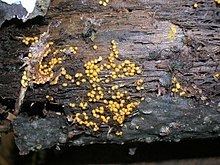Kingdom Fungi | Genus Nectria Rank Species | |
 | ||
Similar Nectriopsis, Nectria cinnabarina, Nectria coccinea, Nemania, Hypoxylon howeanum | ||
Nectria peziza or Yellow Spot is an ascomycete fungus with bright yellow to orange globose fruiting bodies (0.2 - 0.4 mm across) found on rotting polypores, well rotted deadwood, bark, dung, and decaying cloth. It's globular fruiting bodies (peritheca), quite large for the genus, may be isolated or crowded; they have a slightly prominent black dot at the top, the ostiolum, this being the entrance to the inner cavity; the bodies often collapse into a cup-shape when dry and the colour fades to pale yellow or whitish.
Contents
Synonyms
This fungus has an unusually large number of previous binomials, such as – Sphaeria peziza (1791); Hydropisphaera peziza (1822); Dialonectria peziza (1884); Cucurbitaria peziza (1898); Neuronectria peziza (1957); Byssonectria bryophila (1985); Sphaeria aurea (1823); Nectria aurea (1879); Dialonectria aurea (1884); Cucurbitaria aurea (1898); Byssonectria epigaea; and Nectria epigaea (1879).
Classification
N. peziza belongs to the order Hypocreales within the class Sordariomycetes, usually recognized by their brightly coloured (usually red, orange or yellow), perithecial ascomata, or spore-producing structures.
Distribution
N. peziza has been recorded from Africa (Seychelles); Asia (Japan, Pakistan); Caribbean Islands (Bermuda); Europe (Denmark, Germany); North America (USA, Canada); and New Zealand. It is recorded as growing on a wide range of tree species. In the British Isles it has a wide range of distribution and has been found in England, Northern Ireland, Wales and Scotland. N. peziza has even been found in Antarctica, growing in the Windmill Island group.
